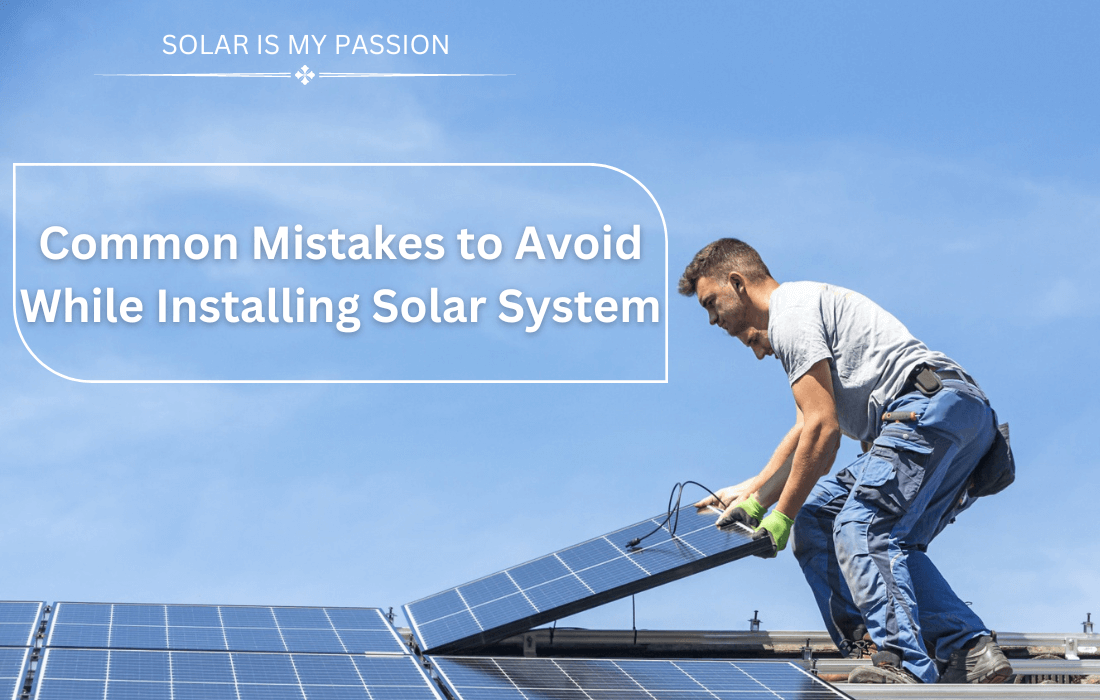Today, adopting environmentally friendly options is more crucial than ever. Concerns about environmental deterioration, which has resulted in issues such as global warming, have prompted a shift to clean, inexpensive, and renewable energy. In this blog, we will explore the very common mistakes that one needs to avoid while Installing solar solutions in India.
Solar Energy is abundant, and it is only profitable to use in our daily life. Solar panels are devices that capture the sun’s heat energy and convert it to electricity. Solar panels not only save a lot of money in the long term, but they also come with extensive warranties to ensure that they operate well. It’s better for the environment, and solar panels are getting more efficient as solar technology advances.
Common Mistakes to Avoid while Installing Solar Solutions in India
1. Lack of Proper Planning
If you don’t prepare ahead of time while developing your solar power system, you may run into issues later. Thinking about current demands is a typical error made while building a solar power system. People rarely consider how their wants may alter in the future.
You may have children, add additional rooms to your house, get an electric car, or establish a home-based company. All of this would increase energy usage. You won’t be able to grow your system in the future if you don’t know the factors in these items at the time of planning.
Make sure you have enough room to extend your present setup. Where will you put more panels in the future if the panels now cover the entire roof? Another consideration is if the system is meant to grow. Expand the system, it’s not as simple as adding additional panels. Other components, such as the inverter, must be scaled to match.
Battery size is also an important consideration for an off-grid solution. It’s possible that your current battery bank isn’t extendable. Lithium battery banks can be enlarged, but lead-acid batteries only have a limited number of alternatives. This is because new lead-acid batteries tend to absorb the properties of older ones. As a result, the fresh batteries may begin to age prematurely.
2. Building an unsystematical System
Recycling and reusing are all good ideas, but when it comes to solar system installation, they’re not so much. You can’t just slap different elements of the solar system together and call it a day if you’ve collected them through time from various sources.
Compatible parts are required for the solar-powered system, just as they are for conventional devices. Otherwise, you might end up with undersized inverters, various-sized panels, components with different connections, and a power center that is missing key components, among other issues.
3. Off-Grid is not necessary
It’s a frequent myth that when you install a solar power system, you’ll be cut off from the power grid in your city. That would be a miscalculation.
Solar panels allow you to create your energy and eliminate the need to pay for electricity from the grid. You will, however, require a method of storing the energy generated by solar panels for later use. You can store this energy in the electric utility system if you have access to power lines.
So, rather than an off-grid solar system, you’re seeking a grid-tied solar system. This technology enables you to generate electricity for your house while also selling it to the state government. You’ll also get a five-year payback period and 20 years of free electricity.
Because off-grid solar power systems do not have access to power lines, they must rely on a different kind of energy storage. Battery banks can in handy in this situation. Batteries are costly yet necessary for an off-grid solution. They consume a large portion of the solar panels’ return on investment (ROI).
As a result, being connected to the grid will help you avoid making an expensive mistake.
4. Faulty Design
It’s more difficult than it appears on the surface to design a decent solar power system with the correct dimensions. This is why, when it comes to developing and planning the system, it’s advisable to consult professional manufacturers and installers.
If you believe that merely doing enough research to buy panels that cover your energy demand is adequate, you’re overlooking several important aspects. The entire output of your system is determined by climate, panel orientation, natural efficiency decline, shading, and other variables.
A solar technician can advise you on the following topics:
- Efficiency: Solar panels have an efficiency rating, and their efficiency drops by 0.5-1 percent per year. It means they’ll be 10-20% less efficient 20 years after they’re installed. As a result, you should incorporate a little more headroom into your system to accommodate for this loss of efficiency. You may do so by adding a few more panels.
- Location: Solar panels are tested by manufacturers at optimal temperatures ranging from 20 to 25 degrees Celsius. In the actual world, however, your system is subjected to even more severe weather conditions. High temperatures might have a detrimental impact on the amount of energy you create.
The quantity of solar hours you get is determined by your location. The length of time the Sun is in the optimal position to create maximum energy is referred to as “sun hours.” The typical sun hours in India range from 5-8 hours each day. However, the actual number would depend on the condition and affect the system’s size.
- Voltage Rating: Panels and batteries have voltage ratings, but inverters and charge controllers have maximum and minimum voltage input windows. The voltage needs of the devices you’re using determine the design of your system. The voltage and system performance are also affected by temperature. Poor system performance and hardware damage might result from insufficient electricity from solar panels or battery banks.
- Battery Bank Sizing: You’ll need a battery bank if you’re using an off-grid solution. Mismatching the battery bank with the charging source is a typical error with battery banks. Your battery should get sufficient power to keep it charged, but not excessively so that it does not overload.
While overcharging might cause battery damage, undercharging can be considerably worse. Some batteries must be completely charged regularly to avoid premature failure.
5. Solar Power does NOT Prevent Outages
Even if you generate your energy, you can count on your electrical equipment to work even if there is a power outage. This is mostly for solar systems that are connected to the grid. The electricity generated by the panel is stored in the electric utility system. As a result, if the electricity goes out on the grid, yours will as well.
The only option to solve this problem is to install a grid-connected system with battery backup. The basic grid-tied system is operational when the electricity is turned on. The backup battery bank takes over in the event of a power loss. It costs a little extra, but the backup gives you peace of mind, especially if you live in a location with harsh weather.
6. Going Solar is a Bad Investment
Solar energy is, without a doubt, not cheap. It’s a major commitment, and the installation costs a lot of money upfront. Electricity from the power company, on the other hand, isn’t cheap, and it’s only going to grow more costly when nonrenewable resources run out.
Installing a solar power system is far more useful in the long term. Over the warranty period, most grid-tied systems pay for themselves and make you money.
The domestic solar system is a solar system (with a battery backup) that is installed in households in India on average. The cost per kW is around Rs. 1,00,000. Installing a solar system in such a home might result in savings of up to Rs. 8,400 per year.
The investment is predicted to pay off in 10-11 years, with a return on investment (ROI) of roughly 8%.
Commercial solar systems (grid-connected), such as those found in hospitals, industries, offices, resorts, and other commercial buildings, must have a capacity of 25kW. The cost per kW is roughly Rs. 50,000, with yearly savings of around Rs. 14,000 rupees. The investment is projected to pay off in 3-4 years, with a return on investment of roughly 28%.
7. Avoid Leasing Solar Systems
Solar energy is an excellent investment if you have your system. Leasing the system from a third party might reduce the investment’s value. In India, solar leasing was not particularly popular, but more solar businesses are now entering the leasing market. Some of these are Hero Future Energy, SolarTown Energy Solutions, First Green, and SunAlpha Energy.
The issue with leasing is that because the third-party lender owns the system, they are entitled to the incentives. You won’t get the incentives, and you’ll have to pay a higher lease rate as well as interest. It can be more costly than paying for your system.
If you decide to move, leasing makes it more difficult to sell your house. It reduces the number of people who could be interested in buying your house.


